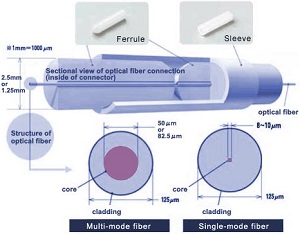Cable Designs
The layout of Fiber
 |
 |
Single-mode
In fiber-optic communication, a single-mode optical fiber (SMF) is an optical fiber designed to carry light only directly down the fiber - the transverse mode. Modes are the possible solutions of the Helmholtz equation for waves, which is obtained by combining Maxwell's equations and the boundary conditions. These modes define the way the wave travels through space, i.e. how the wave is distributed in space. Waves can have the same mode but have different frequencies. This is the case in single-mode fibers, where we can have waves with different frequencies, but of the same mode, which means that they are distributed in space in the same way, and that gives us a single ray of light. Although the ray travels parallel to the length of the fiber, it is often called transverse mode since its electromagnetic vibrations occur perpendicular (transverse) to the length of the fiber. The 2009 Nobel Prize in Physics was awarded to Charles K. Kao for his theoretical work on the single-mode optical fiber
Characteristics
Like multi-mode optical fibers, single
mode fibers do exhibit modal dispersion resulting from multiple
spatial modes but with narrower modal dispersion.[citation needed]
Single mode fibers are therefore better at retaining the fidelity of
each light pulse over longer distances than multi-mode fibers. For
these reasons, single-mode fibers can have a higher bandwidth than
multi-mode fibers. Equipment for single mode fiber is more expensive
than equipment for multi-mode optical fiber, but the single mode
fiber itself is usually cheaper in bulk.[citation needed]
A typical single mode optical fiber has a core diameter between 8
and 10.5 µm[5] and a cladding diameter of 125 µm. There are a number
of special types of single-mode optical fiber which have been
chemically or physically altered to give special properties, such as
dispersion-shifted fiber and nonzero dispersion-shifted fiber. Data
rates are limited by polarization mode dispersion and chromatic
dispersion. As of 2005, data rates of up to 10 gigabits per second
were possible at distances of over 80 km (50 mi) with commercially
available transceivers (Xenpak). By using optical amplifiers and
dispersion-compensating devices, state-of-the-art DWDM optical
systems can span thousands of kilometers at 10 Gbit/s, and several
hundred kilometers at 40 Gbit/s.[citation needed]
The lowest-order bounds mode is ascertained for the wavelength of
interest by solving Maxwell's equations for the boundary conditions
imposed by the fiber, which are determined by the core diameter and
the refractive indices of the core and cladding. The solution of
Maxwell's equations for the lowest order bound mode will permit a
pair of orthogonally polarized fields in the fiber, and this is the
usual case in a communication fiber.
In step-index guides, single-mode operation occurs when the
normalized frequency, V, is less than or equal to 2.405. For
power-law profiles, single-mode operation occurs for a normalized
frequency, V, less than approximately
 |
where g is the profile parameter.
In practice, the orthogonal polarizations may not be associated with
degenerate modes.
OS1 and OS2 are standard single-mode optical fiber used with
wavelengths 1310 nm and 1550 nm (size 9/125 µm) with a maximum
attenuation of 1 dB/km (OS1) and .4 dB/km (OS2). OS1 is defined in
ISO/IEC 11801,[6] and OS2 is defined in ISO/IEC 24702.[7]
The above is from WIKIPEDIA. You can see the entire article here.
Multi-mode
is a method of transmitting information from one place to another by
sending pulses of light through an optical fiber. The light forms an
electromagnetic carrier wave that is modulated to carry information.
First developed in the 1970s, fiber-optic communication systems have
revolutionized the telecommunications industry and have played a
major role in the advent of the Information Age. Because of its
advantages over electrical transmission, optical fibers have largely
replaced copper wire communications in core networks in the
developed world. Optical fiber is used by many telecommunications
companies to transmit telephone signals, Internet communication, and
cable television signals. Researchers at Bell Labs have reached
internet speeds of over 100 petabits per second using fiber-optic
communication.[1]
The process of communicating using fiber-optics involves the
following basic steps: Creating the optical signal involving the use
of a transmitter, relaying the signal along the fiber, ensuring that
the signal does not become too distorted or weak, receiving the
optical signal, and converting it into an electrical signal.
Applications
Optical fiber is used by many telecommunications companies to
transmit telephone signals, Internet communication, and cable
television signals. Due to much lower attenuation and interference,
optical fiber has large advantages over existing copper wire in
long-distance and high-demand applications. However, infrastructure
development within cities was relatively difficult and
time-consuming, and fiber-optic systems were complex and expensive
to install and operate. Due to these difficulties, fiber-optic
communication systems have primarily been installed in long-distance
applications, where they can be used to their full transmission
capacity, offsetting the increased cost. Since 2000, the prices for
fiber-optic communications have dropped considerably. The price for
rolling out fiber to the home has currently become more
cost-effective than that of rolling out a copper based network.
Prices have dropped to $850 per subscriber[citation needed] in the
US and lower in countries like The Netherlands, where digging costs
are low and housing density is high.
Since 1990, when optical-amplification systems became commercially
available, the telecommunications industry has laid a vast network
of intercity and transoceanic fiber communication lines. By 2002, an
intercontinental network of 250,000 km of submarine communications
cable with a capacity of 2.56 Tb/s was completed, and although
specific network capacities are privileged information,
telecommunications investment reports indicate that network capacity
has increased dramatically since 2004.
The above is from WIKIPEDIA. You can see the entire article here.
For more information or help, check these pages out
